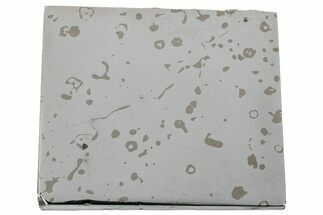This Specimen has been sold.
3.35" Chinga Iron Meteorite (315.3 g) - Historic Meteorite
This is a 315.3 gram piece of the Chinga Iron Meteorite found in Tuva Russia.
The Chinga Iron Meteorite
The Chinga meteorite was discovered in 1913 by gold prospectors in Tuva, Russia near the Chinge River. The supervisor of these gold diggers sent thirty pieces of it to the Russian Academy of Sciences. Later expeditions found about 250 more pieces weighing about 500 pounds total. The meteorite likely fell 10 to 20 thousand years ago, based on the age of the fluvial deposits in which it was found.
The Chinga meteorite was discovered in 1913 by gold prospectors in Tuva, Russia near the Chinge River. The supervisor of these gold diggers sent thirty pieces of it to the Russian Academy of Sciences. Later expeditions found about 250 more pieces weighing about 500 pounds total. The meteorite likely fell 10 to 20 thousand years ago, based on the age of the fluvial deposits in which it was found.
About Iron Meteorites
Iron type meteorites are composed primarily of iron and nickel, and are the remnants of differential cores torn apart at the beginning of the solar system. These metallic meteorites are often the easiest to identify after millions of years post-impact because they are quite different from terrestrial material, especially when it comes to their mass-to-surface area ratio. They are exceptionally heavy for their size since iron is a high-density metal: this is also why the Earth's core is nickel-iron. As planets form, the densest metals form gravitational centers, bringing more and more material into their gravitational pull. In the solar system's rocky planets, these dense materials are most often nickel and iron.
Most iron meteorites have distinctive, geometric patterns called Widmanstätten patterns, which become visible when the meteorite is cut and acid etched. These patterns are criss-crossing bands of the iron-nickel alloys kamacite and taenite that slowly crystalized as the core of the meteorites' parent bodies slowly cooled. Such large alloy crystallizations for mover millions of years and do not occur naturally on Earth, further proving that iron meteorites come from extraterrestrial bodies.
Iron type meteorites are composed primarily of iron and nickel, and are the remnants of differential cores torn apart at the beginning of the solar system. These metallic meteorites are often the easiest to identify after millions of years post-impact because they are quite different from terrestrial material, especially when it comes to their mass-to-surface area ratio. They are exceptionally heavy for their size since iron is a high-density metal: this is also why the Earth's core is nickel-iron. As planets form, the densest metals form gravitational centers, bringing more and more material into their gravitational pull. In the solar system's rocky planets, these dense materials are most often nickel and iron.
Most iron meteorites have distinctive, geometric patterns called Widmanstätten patterns, which become visible when the meteorite is cut and acid etched. These patterns are criss-crossing bands of the iron-nickel alloys kamacite and taenite that slowly crystalized as the core of the meteorites' parent bodies slowly cooled. Such large alloy crystallizations for mover millions of years and do not occur naturally on Earth, further proving that iron meteorites come from extraterrestrial bodies.
TYPE
Iron (Ungrouped)
LOCATION
Ryazan, Tuva, Russia
SIZE
3.35 x 2.65 x 1", Weight: 315.3 grams
CATEGORY
ITEM
#263170
 Reviews
Reviews













